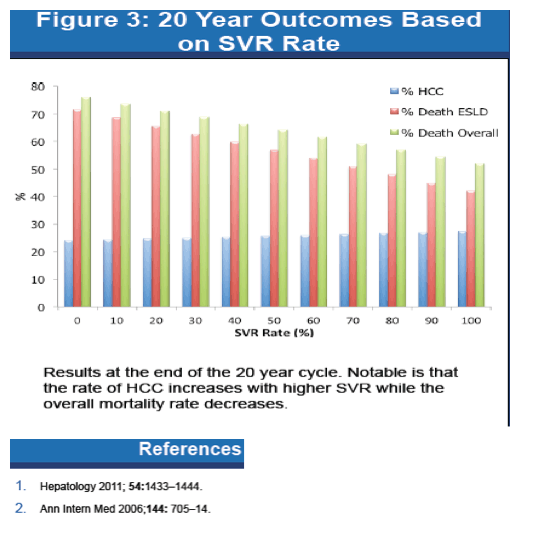 |
 |
 |
| |
IMPACT OF HIGHLY EFFECTIVE ANTIVIRAL THERAPY ON THE BURDEN OF HEPATOCELLULAR CARCINOMA IN HEPATITIS C CIRRHOSIS
|
| |
| |
Reported by Jules Levin
EASL 2013 Amsterdam April 24-28
S.E. Congly, M.D, W.R. Kim, M.D., MBA, L.R. Roberts, M.D., PhD, G.J. Gores, M.D., PhD
Division of Gastroenterology and Hepatology
Mayo Clinic, Rochester, MN
from Jules: this is an interesting analysis, based on modeling estimates. The important take home message is dont wait until one gets cirrhosis to be treated, do not unduly delay HCV treatment, for if one does that risk for developing liver cancer increases. HCV is a systemic disease, it affects the liver & can increase risk for extra-hepatic diseases like cancers. Once HCV gets into the liver it progresses and causes increasing damage to the liver over years, although sometimes slowly but sometimes more quickly, the range is some people can have HCV for 20 years before developing cirrhosis, some may not develop cirrhosis depending on how old you were when you got infected, how long you've had it & how quickly it may progress which varies by individual. With new HCV therapy regimens coming that are interferon-free, 12 weeks in duration and with 95-100% SVR rates being seen in many studies now, treating sooner rather than unduely delaying therapy is a consideration.
THIS STUDY. We know that patients who get successfully treated & achieve SVR after they have developed cirrhosis are still at risk for developing liver cancer, HCC, so this analysis found that & suggests that even with 100% SVR rates with new DAAs the percent of patients with cirrhosis who develop HCC will increase, despite that the percent dying from end-stage-liver disease will decrease, death overall will decrease, the percent no longer at risk for HCC will increase, and the average annual HCC incidence per year will decrease. Although this study focuses on HCV similar concepts can apply in HBV.
EASL: New Oral HCV Drugs at EASL - Report 4A - (05/03/13)
Gilead Reports Interim Data From Phase 2 LONESTAR Study - (05/03/13)




|
| |
|
 |
 |
|
|